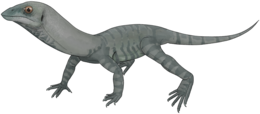Tanystropheidae
| Tanystropheidae | |||
|---|---|---|---|

| |||
| Skeletal reconstruction of Tanystropheus longobardicus
| |||

| |||
| Life restoration of Langobardisaurus | |||
| Scientific classification | |||
| Domain: | Eukaryota | ||
| Kingdom: | Animalia | ||
| Phylum: | Chordata | ||
| Class: | Reptilia | ||
| Clade: | Archosauromorpha | ||
| Clade: | †Tanysauria | ||
| Family: | †Tanystropheidae Gervais, 1858 | ||
| Genera[4] | |||
| |||
Tanystropheidae is an extinct
Tanystropheids are known from Europe, Asia (Russia, China, and Saudi Arabia), North America[5] and probably South America (Brazil).[6] The presence of tanystropheids in Europe and China indicate that they lived along much of the coastline of the Tethys Ocean.[7] However, species in western North America are found in terrestrial deposits, suggesting that as a group, tanystropheids were ecologically diverse.[5]
Relationships among tanystropheid species have been difficult to resolve because most specimens were flattened during fossilization and are preserved two-dimensionally. Three-dimensional fossils are known from Europe and North America.[5]
Phylogeny
In
| Archosauromorpha |
| ||||||||||||||||||||||||||||||||||||||||||||||||||||||||||||||||||||||||||||||||||||||||||||||||
A later 2024 study grouped Tanystropheidae along with Trachelosauridae in the new clade Tanysauria.[9]
